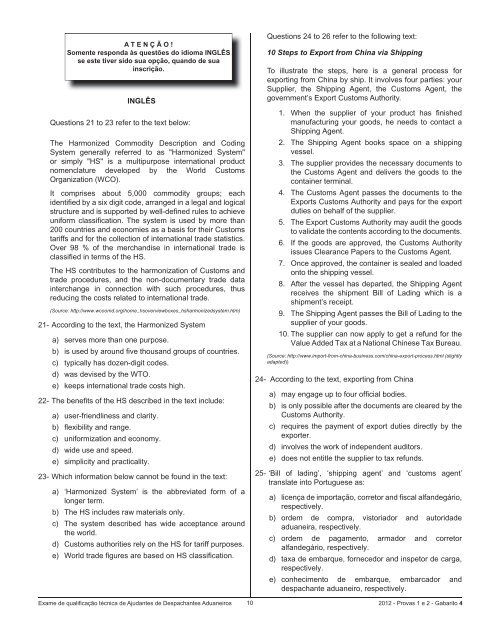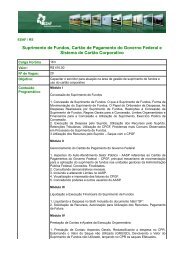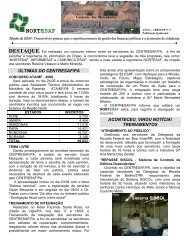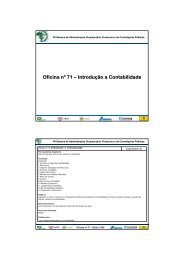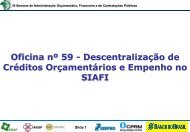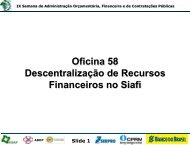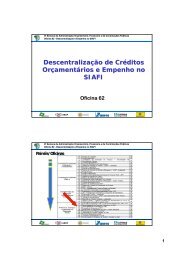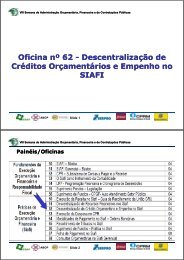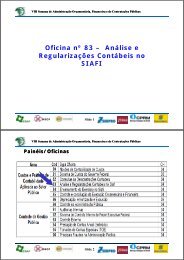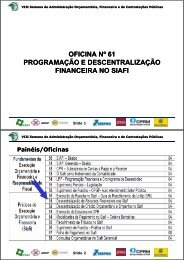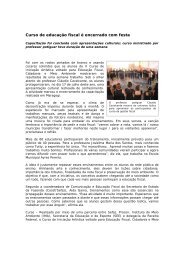Prova Gabarito 4 - Esaf - Ministério da Fazenda
Prova Gabarito 4 - Esaf - Ministério da Fazenda
Prova Gabarito 4 - Esaf - Ministério da Fazenda
You also want an ePaper? Increase the reach of your titles
YUMPU automatically turns print PDFs into web optimized ePapers that Google loves.
A T E N Ç Ã O !<br />
Somente respon<strong>da</strong> às questões do idioma INGLÊS<br />
se este tiver sido sua opção, quando de sua<br />
inscrição.<br />
INGLÊS<br />
Questions 21 to 23 refer to the text below:<br />
The Harmonized Commodity Description and Coding<br />
System generally referred to as "Harmonized System"<br />
or simply "HS" is a multipurpose international product<br />
nomenclature developed by the World Customs<br />
Organization (WCO).<br />
It comprises about 5,000 commodity groups; each<br />
identifi ed by a six digit code, arranged in a legal and logical<br />
structure and is supported by well-defi ned rules to achieve<br />
uniform classifi cation. The system is used by more than<br />
200 countries and economies as a basis for their Customs<br />
tariffs and for the collection of international trade statistics.<br />
Over 98 % of the merchandise in international trade is<br />
classifi ed in terms of the HS.<br />
The HS contributes to the harmonization of Customs and<br />
trade procedures, and the non-documentary trade <strong>da</strong>ta<br />
interchange in connection with such procedures, thus<br />
reducing the costs related to international trade.<br />
(Source: http://www.wcoomd.org/home_hsoverviewboxes_hsharmonizedsystem.htm)<br />
21- According to the text, the Harmonized System<br />
a) serves more than one purpose.<br />
b) is used by around fi ve thousand groups of countries.<br />
c) typically has dozen-digit codes.<br />
d) was devised by the WTO.<br />
e) keeps international trade costs high.<br />
22- The benefi ts of the HS described in the text include:<br />
a) user-friendliness and clarity.<br />
b) fl exibility and range.<br />
c) uniformization and economy.<br />
d) wide use and speed.<br />
e) simplicity and practicality.<br />
23- Which information below cannot be found in the text:<br />
a) ‘Harmonized System’ is the abbreviated form of a<br />
longer term.<br />
b) The HS includes raw materials only.<br />
c) The system described has wide acceptance around<br />
the world.<br />
d) Customs authorities rely on the HS for tariff purposes.<br />
e) World trade fi gures are based on HS classifi cation.<br />
Questions 24 to 26 refer to the following text:<br />
10 Steps to Export from China via Shipping<br />
To illustrate the steps, here is a general process for<br />
exporting from China by ship. It involves four parties: your<br />
Supplier, the Shipping Agent, the Customs Agent, the<br />
government’s Export Customs Authority.<br />
1. When the supplier of your product has fi nished<br />
manufacturing your goods, he needs to contact a<br />
Shipping Agent.<br />
2. The Shipping Agent books space on a shipping<br />
vessel.<br />
3. The supplier provides the necessary documents to<br />
the Customs Agent and delivers the goods to the<br />
container terminal.<br />
4. The Customs Agent passes the documents to the<br />
Exports Customs Authority and pays for the export<br />
duties on behalf of the supplier.<br />
5. The Export Customs Authority may audit the goods<br />
to vali<strong>da</strong>te the contents according to the documents.<br />
6. If the goods are approved, the Customs Authority<br />
issues Clearance Papers to the Customs Agent.<br />
7. Once approved, the container is sealed and loaded<br />
onto the shipping vessel.<br />
8. After the vessel has departed, the Shipping Agent<br />
receives the shipment Bill of Lading which is a<br />
shipment’s receipt.<br />
9. The Shipping Agent passes the Bill of Lading to the<br />
supplier of your goods.<br />
10. The supplier can now apply to get a refund for the<br />
Value Added Tax at a National Chinese Tax Bureau.<br />
(Source: http://www.import-from-china-business.com/china-export-process.html (slightly<br />
a<strong>da</strong>pted))<br />
24- According to the text, exporting from China<br />
a) may engage up to four offi cial bodies.<br />
b) is only possible after the documents are cleared by the<br />
Customs Authority.<br />
c) requires the payment of export duties directly by the<br />
exporter.<br />
d) involves the work of independent auditors.<br />
e) does not entitle the supplier to tax refunds.<br />
25- ‘Bill of lading’, ‘shipping agent’ and ‘customs agent’<br />
translate into Portuguese as:<br />
a) licença de importação, corretor and fi scal alfandegário,<br />
respectively.<br />
b) ordem de compra, vistoriador and autori<strong>da</strong>de<br />
aduaneira, respectively.<br />
c) ordem de pagamento, armador and corretor<br />
alfandegário, respectively.<br />
d) taxa de embarque, fornecedor and inspetor de carga,<br />
respectively.<br />
e) conhecimento de embarque, embarcador and<br />
despachante aduaneiro, respectively.<br />
Exame de qualifi cação técnica de Aju<strong>da</strong>ntes de Despachantes Aduaneiros 10 2012 - <strong>Prova</strong>s 1 e 2 - <strong>Gabarito</strong> 4


